how to tell what kind of bearded dragon you have
Bearded dragons are 1 of the most beloved types of pet lizards, and their popularity continues to explode in the United states of america and elsewhere. Beardies are special. They are fun, friendly, and fascinating to detect.
Bearded dragons are known for bonding with their caretakers in ways that many other reptiles unremarkably do not. A well-cared-for dragon will often show fondness for its possessor, responding to the sound of his or her voice and responding positively to physical affection.
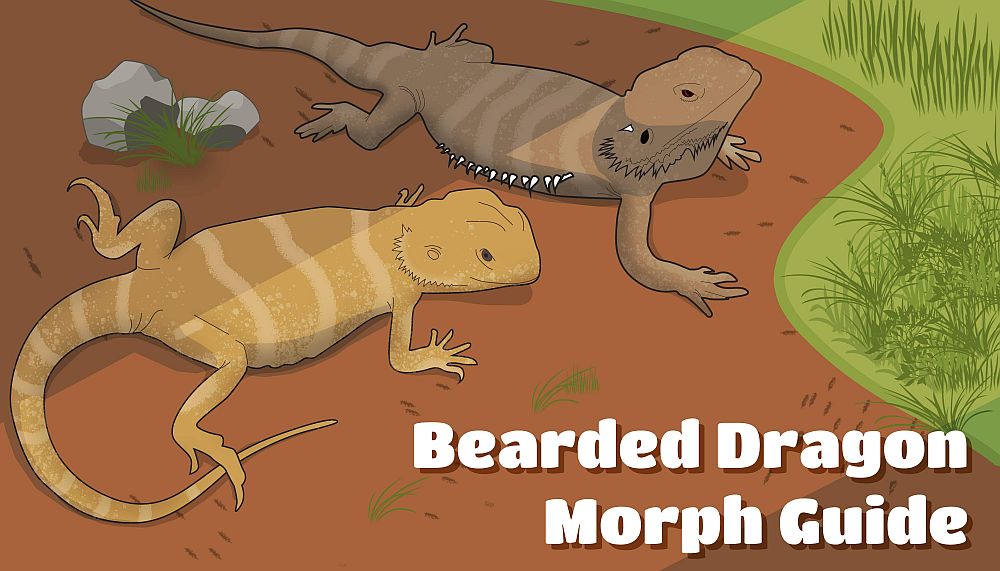
If y'all've thought virtually bringing a lizard into your life (or y'all're only curious about them), you've probably heard about different "bearded dragon morphs"…simply what is a morph?
Morph is a term used to depict different physical characteristics.
Some bearded dragon breeders may refer to color and pattern variations as morph types. However, a true morph is a item genetic mutation known to cause certain traits. This is different than colors and patterns that can occur across different genetic morphs.
A bearded dragon can brandish a combination of morphs and other physical features.
Bearded Dragon Breeding Terminology
Genetics in general is a complicated area of study. Knowing a few basic terms can help you navigate the more than technical data you may come across as you lot read and research nearly disguised dragon morphs.
- Het: Het is short for "heterozygous." This just means that an brute carries a certain trait only does not physically display information technology.
- Selective Breeding: Selective breeding is when two particular types of disguised dragon are mated in an endeavour to create specific outcomes, such as certain colors, patterns or other features.
- Proven: In the world of bearded dragon breeding, the term "proven" refers to an animal that has been successfully bred.
- Recessive Traits: These are traits that come from a recessive gene. For a recessive trait to present visually, information technology must be passed downwardly from both parents.
- Dominant Traits: A dominant trait will be displayed in offspring fifty-fifty if only one parent carries it.
- Co-Dominant Traits: When offspring shows multiple dominant traits, they are considered to be co-dominant.
- Leucism: Leucistic animals produce very petty melanin, making them appear much lighter in color than usual. Witblits, zeros, and hypos are all leucistic. Leucism is different than albinism, which causes an animal to produce no melanin at all.
Colour Variations in Bearded Dragons
Bearded dragons can brandish a variety of colors. The intensity of patterns and colors in bearded dragons tin be a determining factor in how much they are worth on the pet market.
While a beardie's morph variety can impact its coloring, the color of a disguised dragon solitary is not considered a morph. These colors and diverse combination of them can be found within many morph varieties.
- Carmine – Red varieties you may see include red, claret carmine, and red red bearded dragons.
- Orange –Sunburst and tangerine are common names for varieties of orange bearded dragons that are regularly seen from breeders and in pet stores.
- Brown and Tan –The virtually common colors for bearded dragons to display are sandy browns, beiges, and muted tans.
- Yellow –Yellow colored dragons are sometimes chosen sandfire, citrus, lemon, and gold past breeders.
- White and Argent –Some of the leucistic morphs come in shades of white, off-white, silvery, and gray.
Types of Bearded Dragon Morphs
The post-obit list outlines the true morph types for bearded dragons.
Classic or Normal Bearded Dragons
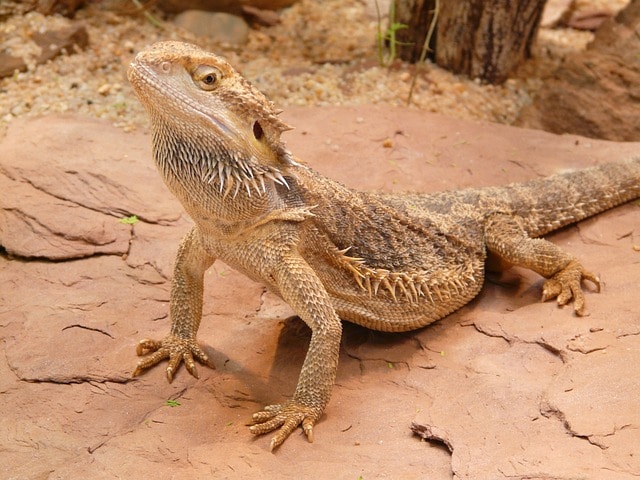
This type of bearded dragon almost closely resembles the ones found in the wild. They have spikes running down their back and sides of their torso. They as well have the signature triangular head and spiky bristles. Virtually often, these come up in shades of tan or brownish. However, they can display a variety of colors including red, yellow, and orange.
Hypomelanistic Bearded Dragons

Hypomelanistic, or "hypo" bearded dragons display lighter coloring than other types. Melanin is pigment that makes the pare of an creature appear darker. Hypomelanism is a recessive trait that causes a disguised dragon to make less melanin, resulting in lighter coloration. Aside from their light coloring, some other signature feature of hypomelanistic beardies is that they take clear nails.
Y'all may see hypos referred to as "pastels" on occasion.
Some types of melanistic morphs you may see are:
- Red Hypomelanistic
- Claret Hypo Orange
- Yellow Hypo
- Hypo Red Crawley
- Ruby Het Hypomelanistic
- Hypo Het Translucent
- English Belgium Hypo
- Hypo Yellow
- Hypo Snow
Leatherback Bearded Dragons
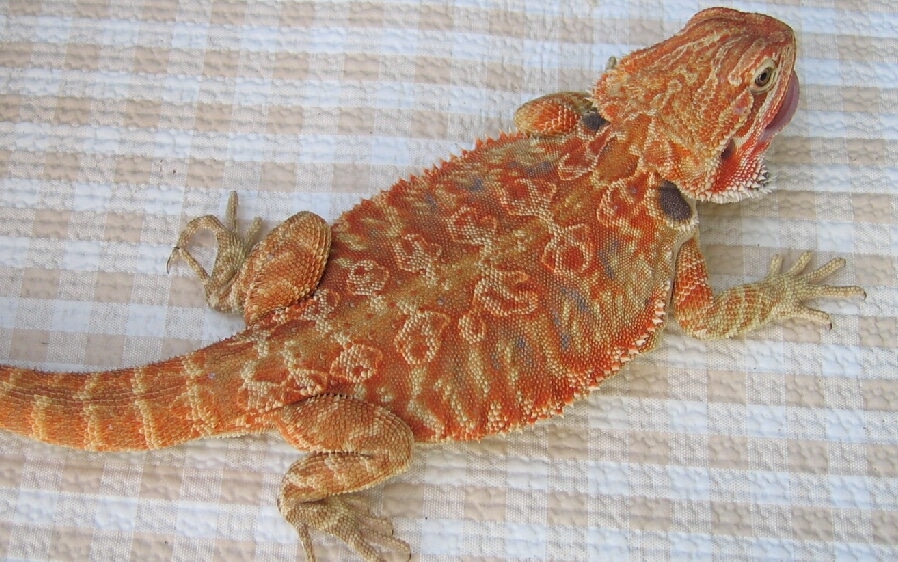
Leatherback bearded dragons are distinguished by their smooth, spikeless backs. They do withal have spikes effectually their heads and forth the sides of their bodies like other beardies, though. The absence of spikes on their backs can cause their coloring to announced more vivid.
Of course, just as with any morph, at that place volition be some variations. Some leatherbacks do have some small spikes on their backs, though they are usually little more than enlarged scales rather than true spikes.
You may come across the terms "American Leatherback" and "Italian Leatherback," both of which are obsolete since the leatherback mutations found in both Italia and the United States are considered to be indistinguishable.
Leatherbacks are more rare than classic and hypomelanistic morphs, making them more expensive to purchase.
Some popular leatherback varieties include:
- Hypo Leatherback
- Het Hypomelanistic Leatherback
- Purple Paradox Leatherback
- Hypo Translucent Leatherback Dunner
Micro Scale Disguised Dragons
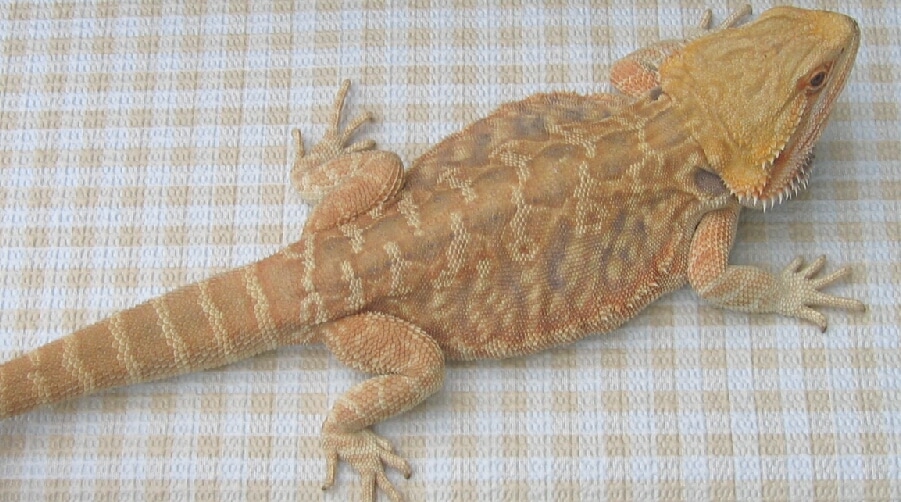
The micro calibration morph comes from combining the co-dominant leatherback mutation with the recessive leatherback mutation. The consequence is a beardie resembling a leatherback but with fewer spikes. They unremarkably do not accept any spikes on their beard or sides of the torso, and the spikes on the back of their head are smaller than normal
Silkback Bearded Dragons
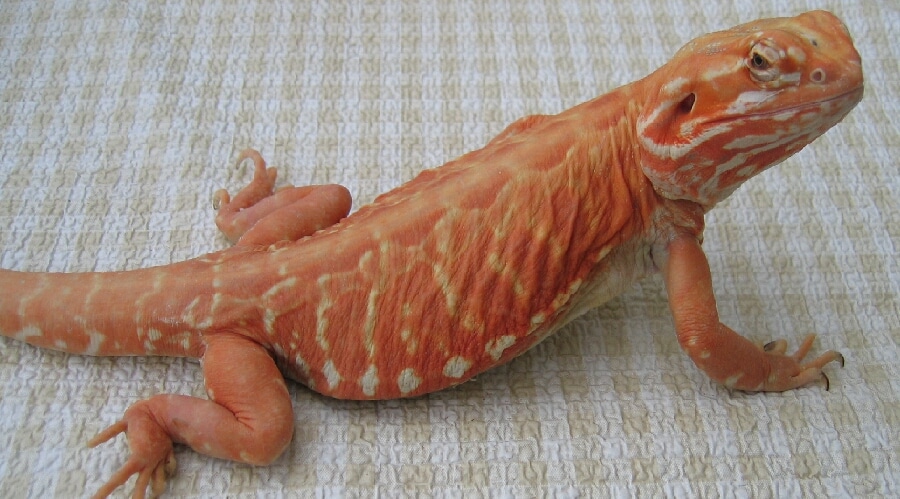
Silkback morphs do not have any spikes or scales on their bodies, which makes them i of the almost unique bearded dragon types. The lack of spikes and scales makes their peel look and experience soft and silky, hence the name. While these types of bearded dragons are certainly intriguing and attractive, it'due south important to note that they can be more than difficult to care for than other varieties.
Not having whatever spikes or scales leaves these lizards with skin that is vulnerable to damage. Considering of this, some breeders will not produce silkback varieties, believing it to be unethical.
If you do stop up with a silkback bearded dragon morph, it's important to take proper care of it. These soft and sensitive beardies will need to exist bathed and moisturized regularly to promote healthy apportionment and to aid proper shedding of one-time pare. Information technology'south extremely important to house silkbacks lonely. Since they are and then vulnerable, fifty-fifty a not-aggressive lizard in the aforementioned tank could inadvertently crusade serious injuries with its nails or spikes.
Additionally, bang-up care should be taken when selecting objects to place in a silkback's enclosure. Rocks, branches, and other items that might normally be fine in a beardie habitat could seriously hurt a silky.
Translucent Disguised Dragons
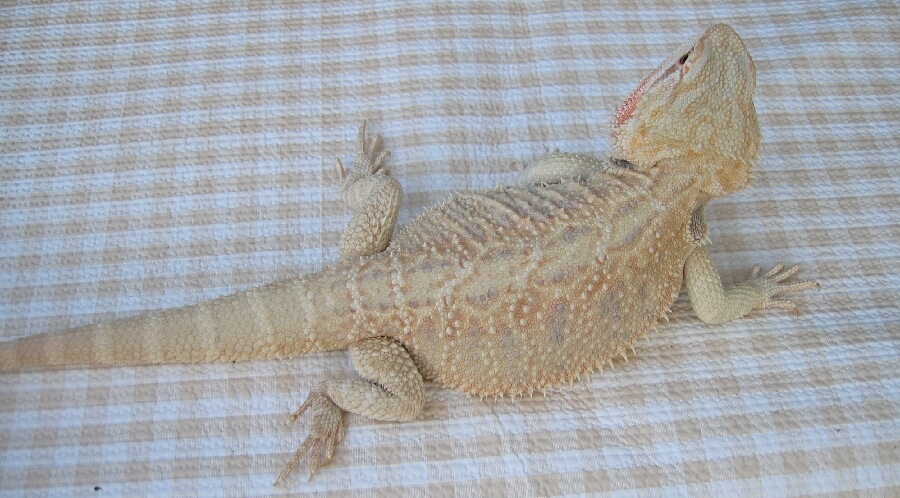
Translucent bearded dragons, sometimes called "trans" morphs, get their name from their somewhat see-through appearance. This is the outcome of a recessive trait. Trans babies have bellies that appear bluish in color, and they may display a bluish tint in other areas as well (particularly in a higher place the eyes).
As their skin grows thicker in machismo, well-nigh translucent beardies lose the bluish coloration, though some do retain the blue throughout their lifetime.
Myth: Trans Morphs are Decumbent to Wellness Problems –You lot may hear or read that translucent bearded dragons are more susceptible to health bug than other morphs. This has never been proven to be truthful, and people have been successfully breeding good for you trans morphs for many years now.
Another distinguishing feature of this morph type is solid black center coloring. Go along in mind, though, that non every trans morph volition accept solid black optics. In fact, translucent morphs may experience changes in the manner their eyes await as they abound. A babe with solid eyes may develop more typical looking eye coloration equally it ages.
Some translucent morphs accept even been known to modify dorsum and along from one kind of eye coloration to another within their lifetime.
Some breeders use the term "partial trans" for translucent morphs that display singular features such every bit not-solid colored eyes. Withal, this is not really accurate. There is no partial translucent morph. There are only trans morphs with typical and atypical features.
Some varieties of the translucent morph y'all may see include:
- Red and Orangish Hypo Translucent
- Hypo Translucent Genetic Stripe and Leatherback Genetic Stripe
- Rally Blood-red Trans
- Citrus Tiger Hypo Translucent
- Dark Translucent
- Hypo Het Translucent
- Polar Translucent
- Kingdom of belgium Translucent
Dunner Bearded Dragons
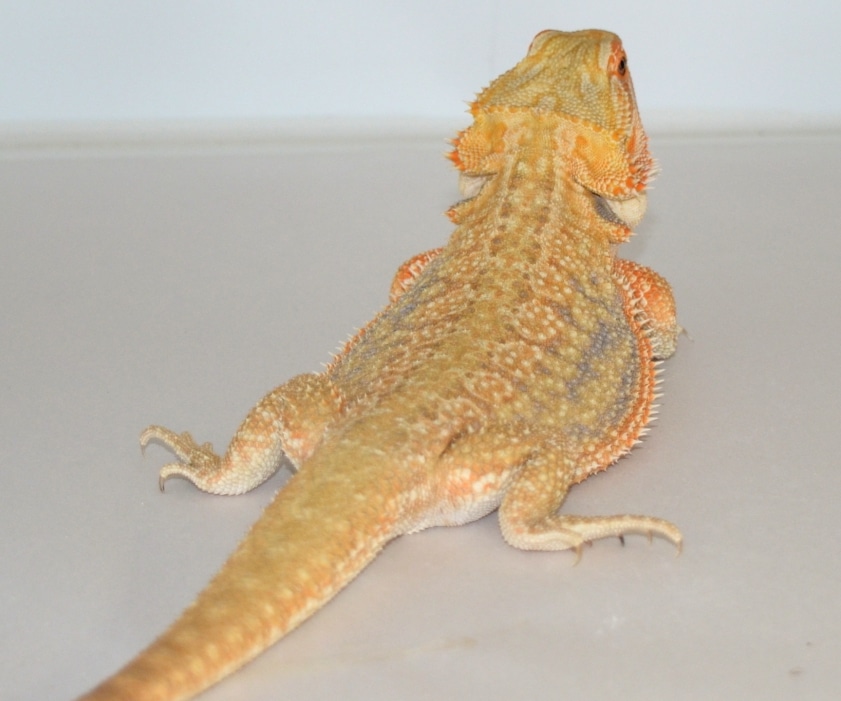
Named afterward the person who first bred them, Dunners display distinctive markings that fix them autonomously from other morphs. Whereas a typical bearded dragon tends to have very organized stripe patterns in very specific locations on the body, Dunner morphs tend to have disorganized patterning that spans their unabridged body. This makes them appear to have spots or speckles, rather than stripes.
Sometimes Dunner varieties are solid-colored, though, which can get in more difficult to tell what blazon of morph they are.
At that place are some additional features that tin exist used to identify a Dunner dragon. Get-go, the management of the scales is dissimilar than usual on Dunner varieties. On near beardies, the beard spikes on the neck point downward. On Dunners, these spikes actually bespeak outward to the sides. Elsewhere on a Dunner, the scales may exist facing multiple directions. This can cause the scales to await more heavily textured and haphazard compared to the same-management scales that lay neatly on virtually other morphs.
Some breeders have noted a peculiar beliefs that seems to only be displayed by Dunner varieties. This is to agree food in the back of their throats before swallowing it. For the nigh office, this does not appear to be harmful or dangerous to the lizard and should non be crusade for business organisation unless the lizard begins to display signs of malnutrition or other health bug.
Some Dunner varieties y'all might run into as you store around are:
- Hypomelanistic Dunner
- Yellow & Orange Hypo Citrus Dunner
- Hypo Translucent Dunner
- Hypo Translucent Leatherback Dunner
Zero Bearded Dragons
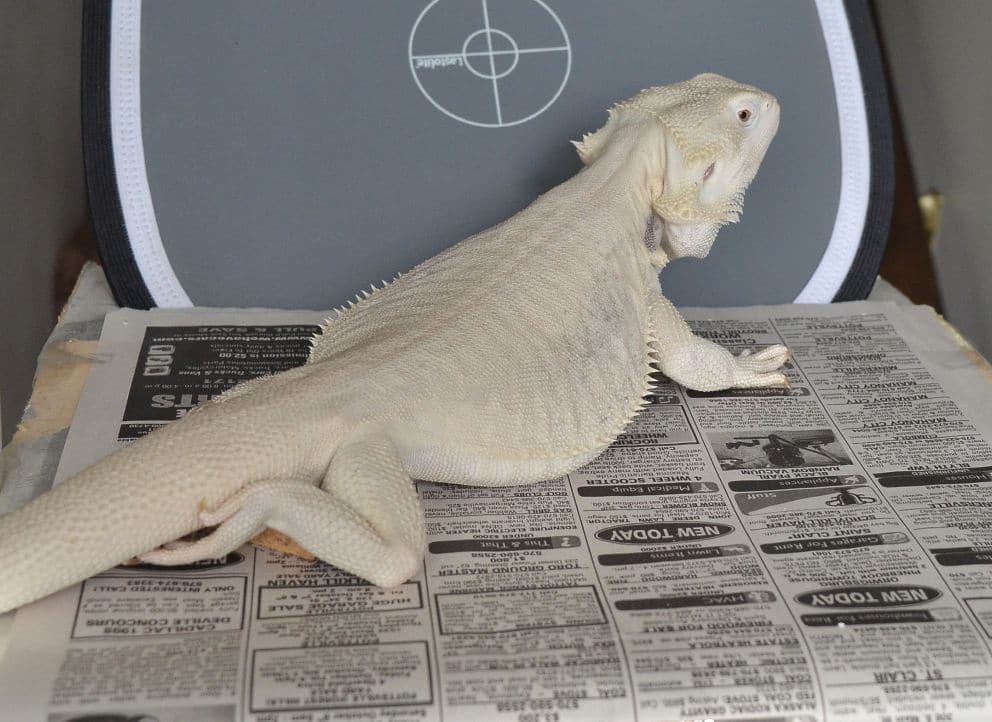
Nada morphs have no colors or patterns (which is the reason behind their proper name). All patternless morphs, including zeroes, are recessive mutations. The Zip morph is known for its hit appearance, and its silverish white coloring makes information technology stand up out amid beardie breeds. Some zeroes are darker greyness in color, but may lighten up somewhat when warm. Zero morphs are still fairly rare, and tin be quite expensive.
Genetic Stripe Bearded Dragons
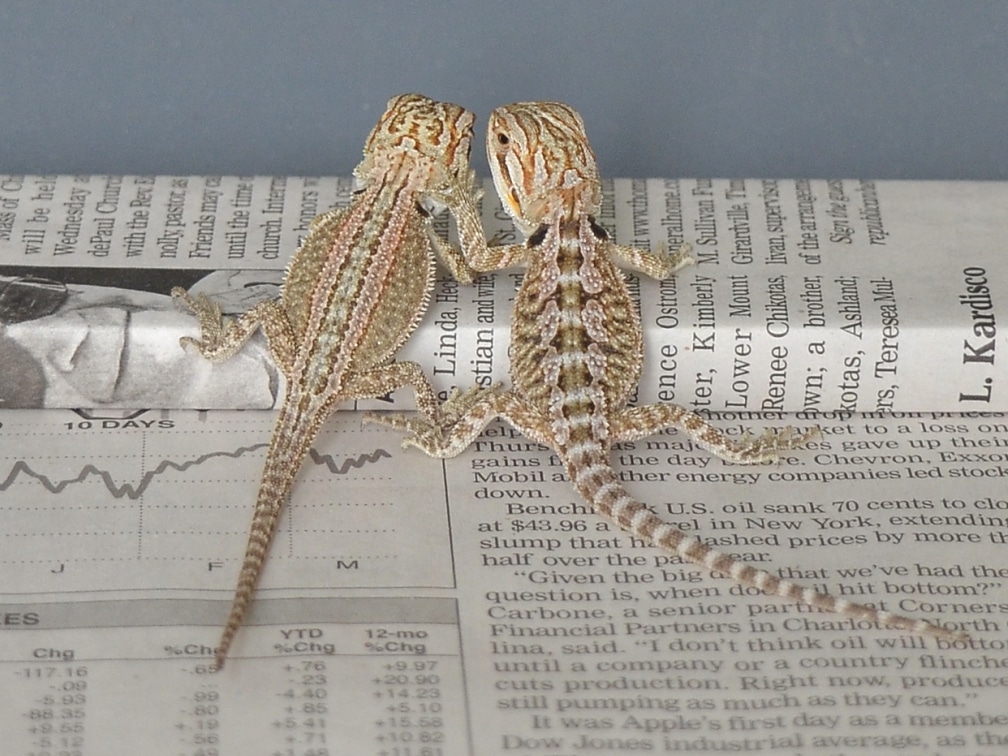
Genetic stripe is a dominant genetic mutation that causes the cadger to display stripes downwards each side of its spine. The stripes are not-colored, and run at least from neck to tail. The master thing to remember with this morph is that "genetic stripe" is the only striped disguised dragon that is a true morph – or displaying a trait caused strictly by a detail genetic mutation.
While breeders may use the word "stripe" as a descriptive describing word, most striping is caused by a combination of factors rather than a unmarried known mutation like the genetic stripe.
High german Giant Bearded Dragons
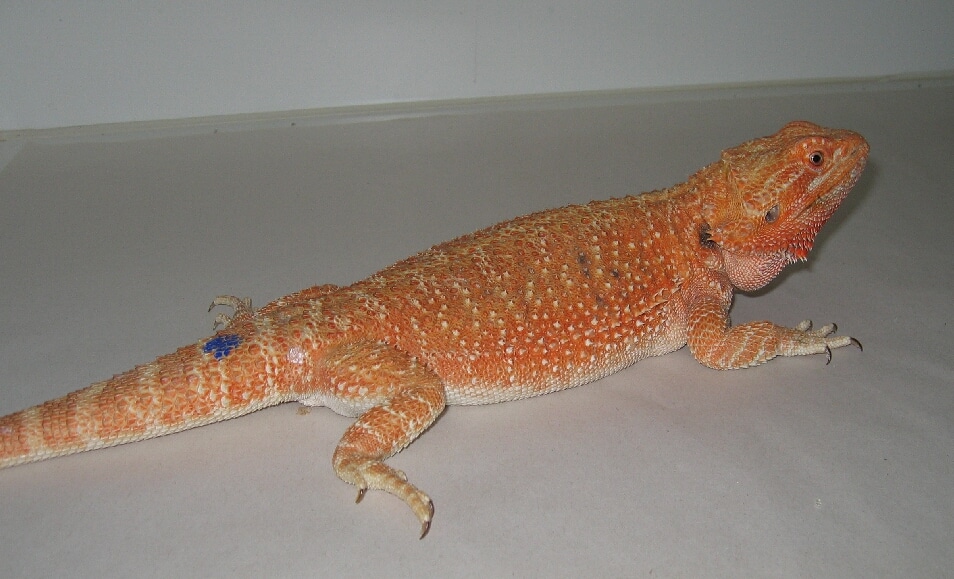
German giants are simply unusually large varieties of classic bearded dragons. It's difficult to tell if a bearded dragon is actually a giant as a hatchling. In fact, you usually tin't tell until it'southward fully grown. If you lot have a giant bearded dragon, be prepared to provide it with an enclosure large enough to thrive in.
Here are some of the varieties of German Giants you may see on the market:
- Greenie Ten Orange German language Giant
- Hypo Cerise Dragon German Giant
Witblits Disguised Dragon
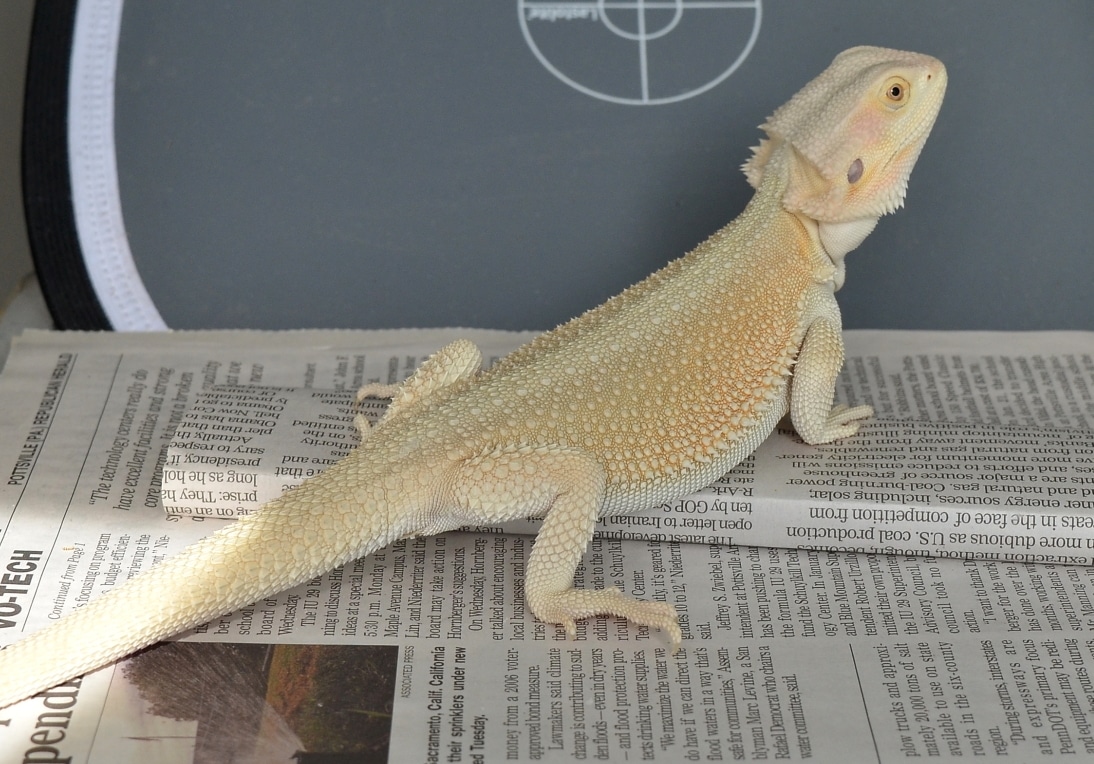
Discovered by a breeder in South Africa, Witblits translates to "white lightning." Notwithstanding, they are non white. At the time of their discovery, though, they were probably the closest thing to a white beardie that anyone had seen (zeroes were discovered shortly afterwards).
Witblits are patternless, and usually display muted globe tones such as sandy brown and light orangish. These rare morphs are commonly very expensive to purchase.
Silverback Bearded Dragons
Before the witblits and zero morphs were discovered, Silverbacks were the only patternless bearded dragons available. Silverback morphs are ordinarily off-white, beige, or brownish in color.
They practice testify patterns as hatchlings, but these slowly fade every bit they abound older. Silverback morphs are not as pop in the United States as the other patternless varieties, and information technology's really quite rare to discover one for sale amongst breeders hither.
This is more often than not because witblits and zeros produce more desirable traits than silverbacks.
Wero Bearded Dragons

White and patternless, the Wero was created by combining the witblits morph with the zero morph. Weros generally wait very similar to zip morphs, merely normally display some darker coloring effectually the tail surface area.
Paradox Bearded Dragons
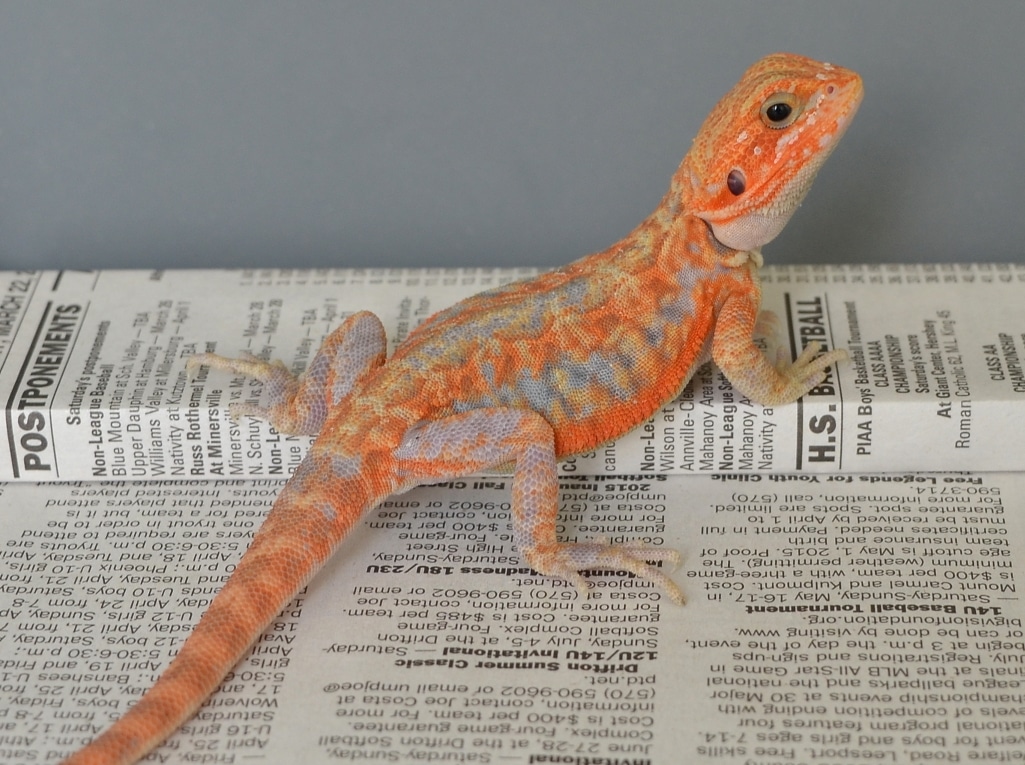
The paradox is easy to distinguish from other varieties due to its striking advent. Paradox morphs are highly sought afterwards and are prized for their beautiful colors and markings. Part of what sets these beardies apart is the unusual fashion their markings announced. On a paradox morph, the colors and markings announced random and tin often look very artistic!
When breeders are measuring the quality (or value) of a particular paradox beardie, they consider two criteria.
- Color
- Paradox Shifts (or distribution and bewitchery of patterns)
The most highly sought-after paradox specimens testify vibrant colors and distinct paradox patches.
The paradox morph is 1 of the to the lowest degree understood among breeders. This is because the paradox traits come from a variety of genetic mutations. The other morphs discussed in this article are all understood to come from one specific mutation.
Some other interesting thing about paradox dragons is that they generally wait like any other beardie upon hatching. Only as they brainstorm to mature do they start to display the signature markings associated with the paradox morph.
Finding a Breeder
After you have determined the bearded dragon morph that you lot would like to purchase, the next step in finding a quality breeder.
I highly recommend staying away from large chain pet stores. Generally, their dragons are not well cared for and little work is put into breeding offspring with high quality genetics.
Instead, I recommend looking into well-known breeders that sell their beaded dragons online. Nosotros highly recommend Dachiu Dragons – they are a great husband and wife team known around the world for their astonishing morphs.
In fact, all of the images higher up are dragons that they own and brood!
Other Things You Should Know About Disguised Dragon Morphs
The best fashion to brand sure y'all're a responsible disguised dragon keeper is to educate yourself as much as possible. Beware of unscrupulous sellers and less-than-reputable breeders. If a breeder is hesitant to answer your questions, find another one. Quality breeders and pet stores will be happy to talk with yous patiently and honestly. On the other paw, be wary of anything that seems "as well good to be true" (such every bit a supposedly rare morph beingness sold for a really low price).
The more than you know most bearded dragons and reptile convenance in general, the more hard it will exist for anyone to take reward of you lot during a transaction.
- Equally bearded dragons mature, the patterns and colors they brandish may modify. Their coloring may become duller, or it might become more brilliant. Also, patterns may get more than or less defined as a cadger grows.
- Disguised dragons tin can await dissimilar in diverse types of lighting. If you're purchasing a bearded dragon based on pictures lone, exist sure what you run across is truly what you'll be getting. Beardy colors can appear more than vibrant in certain lighting. Information technology'southward okay to ask a breeder for photos of a cadger in more than one kind of lighting (for example, one under fluorescent lighting, another in natural light). Also, be aware that people may do less-than-honest things to boost sales – like using photoshop or employing overly dramatic editing.
- Breeders ofttimes use fun descriptions for the patterns on unlike disguised dragons. You may come across terms like "tiger" or "phantom" used in bearded dragon names. Remember that these are not true morphs, but rather merely adjectives used to help depict the physical characteristics of a cadger (and as well to make it sound more interesting to potential buyers).
- "Fancy" is not a morph. Fancy, like the terms discussed previously, is merely a discussion used for breezy description. More often than not, it's a blanket term for any morph that'south not the classic variety. It is often used when the breeder or seller is unsure of the exact morph variety but wants to differentiate information technology from a standard beardie.
- At that place is no pygmy bearded dragon. Sometimes small beardies are labeled as pygmies. Nonetheless, in that location is no truthful genetic morph that produces modest bearded dragons. If you lot see the discussion "pygmy" in reference to a bearded dragon, know that it is a descriptive term and does not guarantee a genetic predisposition to existence smaller than average.
- Convenance bearded dragons is indeed fascinating, only non something that should be done without expertise. Convenance beardies is not as uncomplicated equally just placing two reverse-sex specimens in a tank. If you're interested in becoming a breeder, have time to become educated on all the ins and outs of ethical, responsible breeding. Devil-may-care convenance can be cruel and can produce unhealthy animals that may not thrive.
At that place are no truthful albino bearded dragons. Some of the pattern-less morphs, particularly the white-colored cipher, may be referred to as "albino" when you run across them for auction. However, true albinism comes from a total lack of melanin. Albino animals are non but white, they also have red eyes. Some breeders have reported unsuccessful attempts at creating a salubrious albino bearded dragon morph. So far in that location have been no officially documented genetic albinos.
Source: https://www.reptileadvisor.com/bearded-dragon-morphs/
0 Response to "how to tell what kind of bearded dragon you have"
Post a Comment